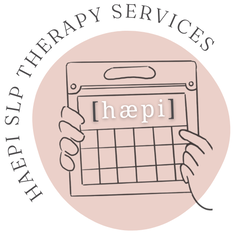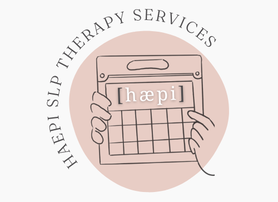|
At HAEPI SLP, our goal is to provide neurodiversity-affirming speech and language therapy to all of our clients.
But what is neurodiversity affirming therapy anyways? Neurodiversity-affirming therapy involves understanding the unique obstacles that neurodivergent individuals face, and validating their experiences while celebrating their differences. At HAEPI, we celebrate the strengths a child already has (using a strength-based instead of deficit-based approach), and allow each child to be their truest, most authentic self by working within while gently expanding their comfort zones. We are committed to fostering connection OVER compliance. The ways we do this include:
So how do we do this in practice? I'll give an example from this week! One of my clients LOVES letters, and instead of "worrying" about a fixation of his interest, I used it in therapy! I hid pieces of a letter puzzle all around a playground, and he was super motivated to find them. I modelled the gestalts "let's find it," "keep looking," "I see it," got it!," "put it together," etc., in play. It was also a joint session with his OT, and because some of his OT goals included climbing on the equipment, he was motivated to do this while searching for his letters. It was also a great opportunity to discuss gestalt language strategies with his OT, and for them to see it work in practice. My therapy feels much more meaningful using these practices, and my clients show MORE speech and language progress when we focus on connection first. by Halle Demchuk, SLPPaediatric SLP | GLP-Trained Clinician | Owner of HAEPI SLP We've taken this past month to listen to Autistic and LGBTQ2S+ communities, and wanted to share some of the things we have learned. It is so important to understand that we cannot be neurodiversity-affirming without also being LGBTQ2S+ allies. We hope you celebrated this month with lots of love and pride! by Halle Demchuk, SLPPaediatric SLP | GLP-Trained Clinician | Owner of HAEPI SLP
Today is National Indigenous Peoples Day in Canada, a day where we recognize and share in honouring the heritage, contributions, resilience, history, and diversity of First Nations, Metis, and Inuit peoples.
This day is especially meaningful to me as a Metis clinician who also works for a First Nations Tribal Council. I continue to learn so much from my clients, co-workers, and the communities to which I have the privilege of traveling. Each community is unique in its culture and practices, and it is on us to show respect by learning from and listening to community members. My SLP class was once asked in grad school, "do you know which reservation/Treaty area is located closest to where you are from?" For me, that was (and still is!) Fort William First Nation. This is such a simple question that we should all be able to answer, Indigenous or not. I hope that when future classes are asked this question, they will not only be able to answer -- but also be able to elaborate and share stories and details (maybe things like landmarks, foods, cultural preferences, etc.) about the Indigenous peoples and communities nearest to them. by Halle Demchuk, SLPPaediatric SLP | GLP-Trained Clinician | Owner of HAEPI SLP
One of the first strategies I encourage those working with gestalt language processors to use is...
Eliminating questions and using declarative language. This is harder than it looks! We ask our children tons of questions each day, and with our GLPs who aren't ready for questions until stages 3+, this can result in frustration for both the adult and the child. We can set our GLPs up for success by naturally modelling declarative language. Try making observations and suggestions while narrating what is happening. This kind of language allows us to share an experience while taking the pressure off the child to respond in a particular way. We also want to validate the language the child uses. I try to repeat what is said so they know I hear them and what they say really matters to me! The benefits of using declarative language include:
I encourage you to try asking *NO QUESTIONS* the next time you play with a GLP. I still catch myself doing it! by Halle Demchuk, SLPPaediatric SLP | GLP-Trained Clinician | Owner of HAEPI SLP
One of the biggest reasons we don't see progress with AAC is because the device isn't being used enough across all environments. A communication device (often an iPad) isn't just something that should be pulled out during speech sessions and then tucked away, it is the child's *voice* and needs to be accessible across all situations.
Wouldn't it be silly if we only gave a child who needed glasses their glasses when they were at the optometrist? The same thing goes for AAC! Some kids might use a combination of verbal speech and a speech-generating AAC system, but it is up to THEM to decide when they need which system... not us. Kids also learn AAC the same way verbal language is acquired -- by having consistent input by different users across all environments. We need to model the use of the device, and immerse the child in its language, for them to use it independently. So please, take it out at recess, bring it to gym, explore with it at lunch! These are often moments in the day that are meaningful to our children, and we can model so much valuable language input during these activities. Plus, there are many great iPad cases out there can protect the device across all environments. I personally think the trade off is more than worth it! I'll end with a quote that always resonates with me on this topic: "The average 18 month old child has been exposed to 4380 hours of oral language at a rate of 8 hours/day from birth. A child who uses a communication system and receives speech/language therapy 2 times a week of 20-30 minute sessions will reach the same amount of language exposure after 84 years." --Jane Korsten So let's ask ourselves... is it really the kids who aren't progressing, or are WE responsible for not providing the input and therefore limiting their success? by Halle Demchuk, SLPPaediatric SLP | GLP-Trained Clinician | Owner of HAEPI SLP |
The HAEPI BlogCheck here for HAEPI updates, helpful SLP information, free resources, articles, and more!
Archives
June 2024
Categories
All
|
Empowering Happy Communicators |
get in touch |
Quick Links |
© HAEPI SLP THERAPY SERVICES.
HAEPI SLP Therapy Services is proudly neurodiverse, Indigenous-owned, and woman-operated.







